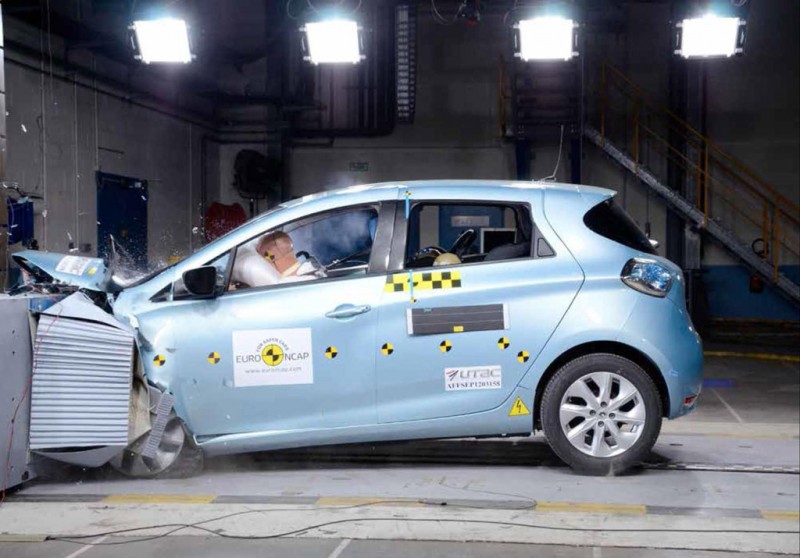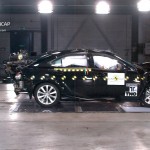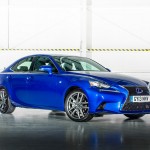Safety in crashes is a major consideration for many car buyers and as such is an area manufacturers take extremely seriously. It is a boon for electric cars that they’re able to hide away core heavy components such as batteries and electric motors allowing for crumple zones and impact areas to be far more efficient than their internal combustion powered counterparts may offer.
Firstly, Renault’s ZOE all electric supermini scored a commendable five out of five and topped the class including against internal combustion engined vehicles.
Renault achieved this by designing the vehicle from the outset with the strictest safety guidelines in mind. In addition to Euro NCAP requirements, careful attention was paid to two areas specific to electric vehicles; their battery and near-silent running.
Batteries were considered just as sensitive as a conventional fuel tank, so safety specialists focused on this area of the car. The Renault ZOE’s battery casing was reinforced to protect the modules inside, while the wiring was routed to prevent risk of damage. The battery itself was subjected to a comprehensive range of tests, including exposure to flames, immersion, combustion, electrical overload, short circuiting, compression, dropping from a height and the so-called ‘nail penetration test’ (which involves driving a nail into a cell). Following the car’s crash test, the battery remained intact but an automatic circuit breaker was incorporated in the system as an added precautionary measure.
Meanwhile, electric vehicles make very little noise at speeds up to about 18 mph, so ZOE is equipped with “Z.E. Voice”, which warns pedestrians and other road users of the vehicle’s approach when travelling between 1 to 18 mph (at a standstill, the car is completely silent).
This sound was custom engineered to achieve an identity that mirrors ZOE’s character and was developed in association with sound perception and design specialists from France’s Acoustic/Music Research and Coordination Institute (IRCAM). Drivers can actually choose from three different sounds, dubbed ‘Pure’, ‘Glam’ and ‘Sport’. They are also free to cut the sound at the press of a switch, although it automatically resumes the next time they turn on the car on for safety.
The second car to mention is the Lexus IS 300h, also rated top of it’s class by Euro NCAP. The full hybrid saloon achieved the highest ratings in the “large family” category in the organisation’s 2013 safety performance testing programme, achieving the top overall five-star rating and an overall 91 per cent score.
The IS 300h excelled in each area of testing, including adult occupant safety (91 per cent), child occupant safety (85 per cent), pedestrian protection (80 per cent) and safety assist features (66 per cent).
In its test report, Euro NCAP noted the effectiveness of the active pop-up bonnet, a feature fitted as standard to all models in the IS range. Sensors in the front bumper detect when a pedestrian has been struck and trigger a system that instantaneously raises the height of the bonnet, increasing its clearance over the engine and other hard elements. Tests also commended the performance of the front bumper and leading edge of the bonnet, which secure a maximum score for the protection offered to a pedestrian’s legs and pelvis.
In American, Euro NCAPs equivalent is known as the NHTSA who recently rated the Tesla Model S as the safest car they’d ever tested. This week’s news comes in from Renault and Lexus, both achieving top marks in their respective categories for two vehicles.
It seems then that despite the fears put out by certain motoring press about electric car safety, having a large engine lump in the front of the car is likely to be the major reason why ICE cars are not as safe as electric cars in general.
There are exceptions and the BMW i3’s recent four star rating by Euro NCAP, is likely to have disappointed BMW greatly. That’s not suggesting it is in any way an unsafe car as in reality the car was marked down particularly for pedestrian friendliness due to the bonnet design.
Time will tell as to the overall safety of electric cars and needless to say that travelling anywhere by vehicle at any speed doesn’t come without risk. What is clear is that electric cars have been developed with safety in mind in a big way and the battery technology is certainly made very safe.
Source; Renault & Lexus



